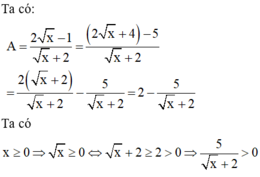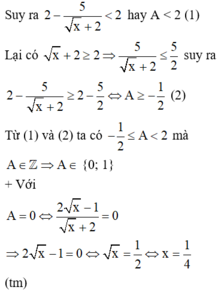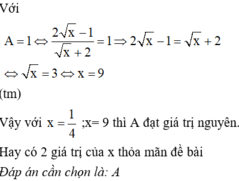



Hãy nhập câu hỏi của bạn vào đây, nếu là tài khoản VIP, bạn sẽ được ưu tiên trả lời.





1111111111111111111111111111111111111111111111111111111111111111111111111111111111111111111111111111111111111111111111111111111111111111111111111111111111111111111111111111111111111111111111111111111111111111111111111111111111111111111111111111111111111111111111111111111111111111111111111111111111111111111111111111111111111111111111111111111111111111111111111111111111111111111111111

a, \(A=\left(\frac{1}{\sqrt{x}+2}-\frac{1}{\sqrt{x}-2}\right):\frac{-\sqrt{x}}{x-2\sqrt{x}}\)
\(A=\left(\frac{\sqrt{x}-2}{\left(\sqrt{x}+2\right)\left(\sqrt{x}-2\right)}-\frac{\sqrt{x}+2}{\left(\sqrt{x}-2\right)\left(\sqrt{x}+2\right)}\right):\frac{-\sqrt{x}}{\sqrt{x}\left(\sqrt{x}-2\right)}\)
\(A=\frac{\sqrt{x}-2-\sqrt{x}-2}{\left(\sqrt{x}+2\right)\left(\sqrt{x}-2\right)}\cdot\frac{-\sqrt{x}\left(\sqrt{x}-2\right)}{\sqrt{x}}\)
\(A=\frac{4}{\sqrt{x}+2}\)
b, \(A=\frac{4}{\sqrt{x}+2}=\frac{2}{3}\)
=> 2cawn x + 4 = 12
=> 2.căn x = 8
=> căn x = 4
=> x = 16 (thỏa mãn)
c, có A = 4/ căn x + 2 và B = 1/căn x - 2
=> A.B = 4/x - 4
mà AB nguyên
=> 4 ⋮ x - 4
=> x - 4 thuộc Ư(4)
=> x - 4 thuộc {-1;1;-2;2;-4;4}
=> x thuộc {3;5;2;6;0;8} mà x > 0 và x khác 4
=> x thuộc {3;5;2;6;8}
d, giống c thôi

d, \(\frac{3x}{x+2}=\frac{3\left(x+2\right)-6}{x+2}=3-\frac{6}{x+2}\)
\(\Rightarrow x+2\inƯ\left(6\right)=\left\{\pm1;\pm2;\pm3;\pm6\right\}\)
| x + 2 | 1 | -1 | 2 | -2 | 3 | -3 | 6 | -6 |
| x | -1 | -3 | 0 | -4 | 1 | -5 | 4 | -4 |
e, \(C=\frac{A}{B}>0\Rightarrow\frac{3x}{x+2}.\frac{x+2}{x^2+2}=\frac{3x}{x^2+2}>0\)
\(\Rightarrow3x>0\Rightarrow x>0\)vì \(x^2+2>0\)
Kết hợp với đk vậy \(x>0;x\ne\pm2\)
f, vừa hỏi thầy, nên quay lại làm nốt :>
f, Để \(\left|C\right|>C\Rightarrow C< 0\)vì \(\left|C\right|\ge0\)
\(\Rightarrow C=\frac{3x}{x^2+2}< 0\Rightarrow3x< 0\Leftrightarrow x< 0\)

1. \(x=\frac{1}{9}\) thỏa mãn đk: \(x\ge0;x\ne9\)
Thay \(x=\frac{1}{9}\) vào A ta có:
\(A=\frac{\sqrt{\frac{1}{9}}+1}{\sqrt{\frac{1}{9}}-3}=-\frac{1}{2}\)
2. \(B=...\)
\(B=\frac{3\sqrt{x}\left(\sqrt{x}-3\right)}{\left(\sqrt{x}+3\right)\left(\sqrt{x}-3\right)}+\frac{\sqrt{x}\left(\sqrt{x}+3\right)}{\left(\sqrt{x}-3\right)\left(\sqrt{x}+3\right)}-\frac{4x+6}{\left(\sqrt{x}-3\right)\left(\sqrt{x}+3\right)}\)
\(B=\frac{3x-9\sqrt{x}+x+3\sqrt{x}-4x-6}{\left(\sqrt{x}-3\right)\left(\sqrt{x}+3\right)}\)
\(B=\frac{-6\left(\sqrt{x}+1\right)}{\left(\sqrt{x}-3\right)\left(\sqrt{x}+3\right)}\)
3. \(P=A:B=\frac{\sqrt{x}+1}{\sqrt{x}-3}:\frac{-6\left(\sqrt{x}+1\right)}{\left(\sqrt{x}-3\right)\left(\sqrt{x}+3\right)}\)
\(P=\frac{\sqrt{x}+3}{-6}\)
Vì \(\sqrt{x}+3\ge3\forall x\)\(\Rightarrow\frac{\sqrt{x}+3}{-6}\le\frac{3}{-6}=-\frac{1}{2}\)
hay \(P\le-\frac{1}{2}\)
Dấu "=" xảy ra <=> x=0